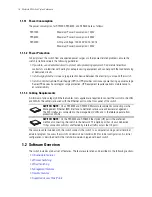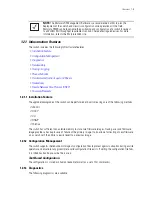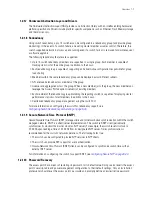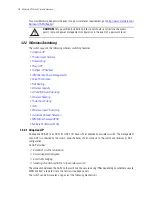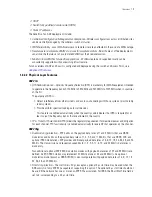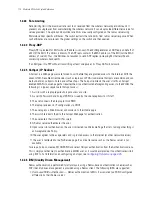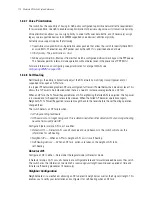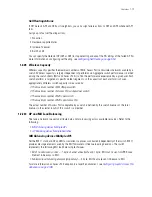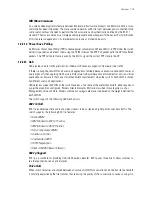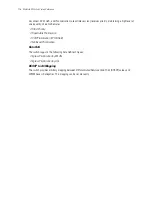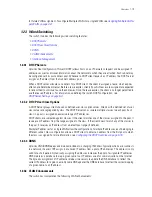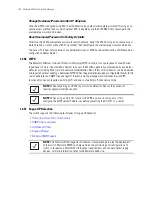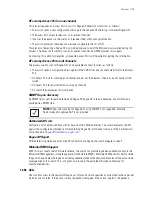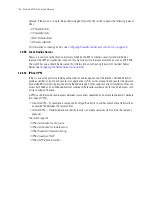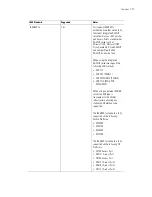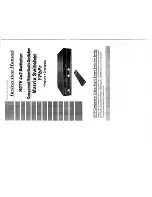
Overview
1-17
1.2.2.14 Wireless Layer 2 Switching
The switch supports the following layer 2 wireless switching techniques:
• WLAN to VLAN
• MU User to VLAN
• WLAN to GRE
1.2.2.15 Automatic Channel Selection
Automatic channel selection works sequentially as follows:
1. When a new AP is adopted, it scans each channel. However, the switch does not forward traffic at this
time.
2. The switch then selects the least crowded channel based on the noise and traffic detected on each
channel.
3. The algorithm used is a simplified maximum entropy algorithm for each radio, where the signal strength
from adjoining AP's/MU's associated to adjoining AP's is minimized.
4. The algorithm ensures adjoining AP's are as far away from each other as possible (in terms of channel
assignment).
1.2.2.16 WMM-Unscheduled APSD
This feature is also known as WMM Power Save or WMM-UPSD (
Unscheduled Power Save Delivery
).
WMM-UPSD defines an unscheduled service period, which are contiguous periods of time during which the
switch is expected to be awake. If the switch establishes a downlink flow and specifies UPSD power
management, it requests (and the AP delivers) buffered frames associated with that flow during an
unscheduled service period. The switch initiates an unscheduled service period by transmitting a trigger
frame. A trigger frame is defined as a data frame (e.g. an uplink voice frame) associated with an uplink flow
with UPSD enabled. After the AP acknowledges the trigger frame, it transmits the frames in its UPSD power
save buffer addressed to the triggering switch.
UPSD is well suited to support bi-directional frame exchanges between a voice STA and its AP.
1.2.2.17 Multiple VLANs per WLAN
The switch permits the mapping of a WLAN to more than one VLAN. When a MU associates with a WLAN,
the MU is assigned a VLAN by means of load balance distribution. The VLAN is picked from a pool assigned
to the WLAN. The switch tracks the number of MUs per VLAN, and assigns the least used/loaded VLAN to
the MU. This number is tracked on a per-WLAN basis.
A broadcast key, unique to the VLAN, encrypts packets coming from the VLAN. If two or more MUs are on
two different VLANs, they both hear the broadcast packet, but only one can decrypt it. The switch provides
each MU a unique VLAN broadcast key as part of the WPA2 handshake or group key update message of a
WPA handshake.
NOTE:
Individual radios can be configured to perform automatic channel selection.
Содержание RFS Series
Страница 1: ...M Motorola RFS Series Wireless LAN Switches WiNG System Reference Guide ...
Страница 10: ...TOC 8 Motorola RF Switch System Reference Guide ...
Страница 56: ...2 8 Motorola RF Switch System Reference ...
Страница 334: ...5 52 Motorola RF Switch System Reference 2 Select the MU Status tab ...
Страница 510: ...7 32 Motorola RF Switch System Reference Guide ...
Страница 534: ...8 24 Motorola RF Switch System Reference Guide ...
Страница 570: ...C 14 Motorola RF Switch System Reference Guide ...
Страница 589: ......
Страница 590: ...MOTOROLA INC 1303 E ALGONQUIN ROAD SCHAUMBURG IL 60196 http www motorola com 72E 132942 01 Revision C December 2010 ...


